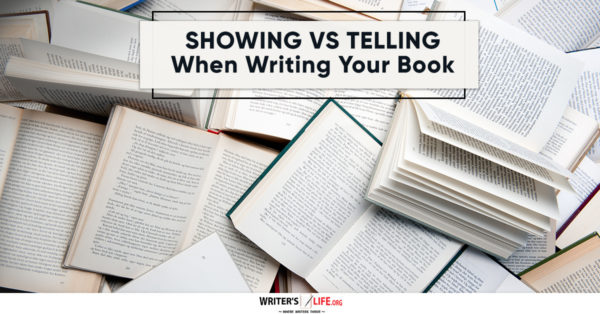- How To Tackle Jealousy In Creative Writing
- Common Submission Mistakes
- How To Stop Your Blog Becoming Boring
- The One Thing Every Successful Writer Has In Common
- How To Make Yourself Aware Of Publishing Scams
- Why Almost ALL Writers Make These Grammar Mistakes At Some Point
- 5 Tips For Authors On How To Deal With Rejection
- Top Mistakes to Avoid When Writing a Novel
- How to Avoid Common New Writer Mistakes
- 10 Mistakes New Fiction Writers Make
Showing Vs Telling When Writing Your Book

One of the most common pieces of advice that we hear given to authors when writing their novels is to make sure that we ‘show’ the reader as opposed to telling them.
But what exactly does this mean?
Showing is where you let the reader see for themselves what is going on, or get them to understand how a character is feeling because of the way they speak, act, or move. Telling is when you just push the reader to one side and explain it yourself.
‘She felt good’
‘The land was poor and famine had spread.’
Telling is generally criticised as it demonstrates the writer's inability to find clever ways of describing things or being able to trust that their reader will get a sense of what they mean without explicitly saying so.
However, despite telling having an awful reputation in the writing world, it is rather impossible to completely avoid it when writing a novel, and, do you know what? That’s OK.
The problem with labouring the showing vs. telling advice is that some writers get so bogged down in the idea that if they ‘tell’ their readers anything they have failed as a writer that they end up making their writing worse. The truth is all authors tell it like it is at some points in their novel, and for the most part, this is entirely accepted by the reader, in fact, they barely notice it at all.
So when is it acceptable to use telling as a writing tool?
To keep your novel flowing well
Telling is obviously a much quicker way of moving the story forward then showing would be. Writing ‘she was devastated’ takes a lot less room then ‘she bent her head, squeezed her eyes tightly shut, clasped the book to her chest and wept.’ If you need to move the scene forward, or don’t want the reader to pay too much attention then it is OK to use the telling device.
To relay action
You used up all your showing language two chapters ago when the action happened, now character A has to tell character B about it. You don’t need to repeat the whole sequence again. The reader already knows what happened and to go into massive detail again would bore them. Sometimes you need to summarise by telling to keep the reader interested in what you, or rather what your characters, have to say.
To create drama
Sometimes telling is more effective than showing when it comes to dramatic impact. Creating distance between your characters can be useful. For example, if one character is watching another leave or you simply want it to be clear what they are thinking telling can be a better device to use.
‘She prayed he would never return’
‘She wondered if he would survive the night.’
To give information
If you simply want to give the reader valuable information telling is going to work better than showing. Trying to show the reader absolutely everything will make your writing seem too indulgent and laborious. If a piece of information is crucial to your story doing so succinctly is often best, and so telling the reader can work well.
We all tell story’s - in fact, it’s even called storytelling, not storyshowing! So don’t be afraid to tell your readers something when you need to. You just need to do it in a way that fits seamlessly into your story so the reader barely notices it and it doesn’t feel like the author is suddenly appearing on the page and getting in the way!
Accepting that you have to tell sometimes will free you as a writer, stop you getting bogged down in your story and probably make your writing better too!

Bethany Cadman -author of 'Doctor Vanilla's Sunflowers'
























